

 |
|
UPCOMING EVENTS
|
EAGE
2010
Barcelona, Spain
June 14-17 |
 |
EAGE
2010
Zurich, Switzerland
Sept 6-8 |
 |
SEG
2010
Denver, Colorado
October 17-22 |
 |
Geo
India 2011
New Delhi
Jan 12-14 |
 |

|
|
EX-12 Distributed Exploration
Seismograph - NEW
| The EX-12 is a new product that shares the same technology used
in the EX-6. With 12-channels per box, an EX-12 system needs
half the number of boxes, cables, and batteries compared to an EX-6
system, which simplifies
field deployment. The EX-12 can be used as a standalone 12-channel
seismograph for simple applications or multiple EX-12 acquisition
units units can be
connected together to form larger systems for both 2D and 3D
applications. The EX-12 also provides a
continuous acquisition
mode that can record data from hundreds of channels for hours,
limited only by the available disk space. This feature is
useful for emerging seismic techniques such as seismic
interferometry and MASW. |
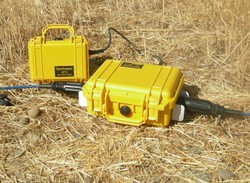
EX-12 12-Channel Box
|
-
24-Bit
Delta-Sigma A/D conversion
-
3,200 Channels on
32 lines
-
2D and 3D
operation
-
Wide
dynamic range (120db @ 2ms)
-
Lightweight, rugged, waterproof case
-
Fully automated system
performance tests
-
Intuitive
operation under Windows XP/Vista
-
3D Operation controlled by Mesa
Script files
-
Continuous recording for seismic
interferometry and MASW
|


 APPLICATIONS
APPLICATIONS

- Oil &
gas exploration
- Mineral
exploration
- Geotechnical
surveys
- Engineering
geology
- VSP and
tomography
|
|
- Depth-to-rock
- Fault
location
- Site
remediation
- Surface
wave analysis
- Teaching
and research
- Seismic Interferometry
|
The EX-12 Explorer is
a versatile, cost-effective seismic data acquisition system intended for high
resolution 2D and 3D reflection surveys. The system combines 24-bit A/D
performance in a rugged twelve-channel box that supports 600 channels of
real-time seismic data acquisition in single line operation, and up to 2400
channels on 32 lines in Multiline (3D) operation.
The main elements of the EX-12 system are the Windows laptop running the EX-12
System Software, the EX-12 Acquisition Units (AU), Line Tap Units (LTU), AUX
unit, and Line Interface Unit (LIU). AUs are connected together with eight-pair
spread cables with twelve geophone takeouts between boxes and may be distributed
arbitrarily around the LTU. New boxes are automatically recognized and addressed
by the EX-12 System Software, making the system easy to expand.
 SYSTEM SOFTWARE
SYSTEM SOFTWARE
126
Channel Single Line Shot
The EX-12 System Software runs under Windows XP/Vista and controls all aspects
of data collection, display, storage and printing. The program offers many
features, such as dockable toolbars, Explorer style fileviewer and
context-sensitive right mouse support, while using the built-in networking
facilities of Windows to control operation of the system.
The EX-12 allows you to view the data the way you prefer. Convenient on-screen
controls make it easy to expand or contract the seismic data display, scroll to
a region of interest, and adjust the trace size. Acquired data may be viewed in
wiggle trace, shaded area, and solid variable area, and can be clipped or
inverted, low or high pass filtered, and AGC'd with adjustable mute. The
frequency and period of signals can be easily measured by clicking on the events
of interest and velocity lines with multiple segments can be dragged into
position to measure the velocity of reflectors and can also serve as guides
during firstbreak picking.
For reflection shooting, the EX-12 has line management features such as auto
roll, auto save, auto file increment, and a graphical line geometry display
showing the shot point, roll direction, total number of channels on line, and
active channel positions. And to keep the records straight, the system maintains
a running history of all shooting activity in a shot log that can be easily
viewed and edited by the operator. The spread may be rolled manually or
automatically, and the Look Ahead function can be used to determine how many
boxes are available for roll at the front and back of the spread. The system can
sum up to 99 stacks, with the ability to unstack and restack after each shot and
invert the polarity of stack for shearwave work.
For Vibroseis operation, the EX-12 provides AUX channels with independent preamp
gain settings for recording the pilot sweep and fast, time-domain correlation
for in-field quality control.
|
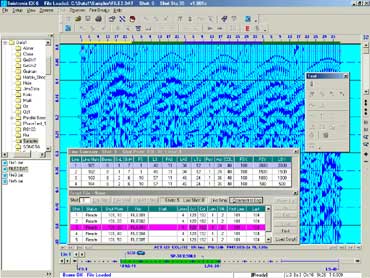 |
|
Five Line, 3D
Shot |
 FIELD TESTING
FIELD TESTING
|
To ensure
that data is accurately recorded, the EX-12 provides an extensive
array of instrument tests that include amplifier noise, dynamic
range, A/D offsets, amplifier pulse, CMR, timing accuracy,
crosstalk, phase similarity and gain similarity. Tests can be
performed individually, or a complete system test can be performed
automatically with the test results logged to disk. To locate
geophone and cable problems before they affect your data, the EX-12
offers geophone resistance, geophone pulse, geophone similarity, and
cable leakage tests.
|
|
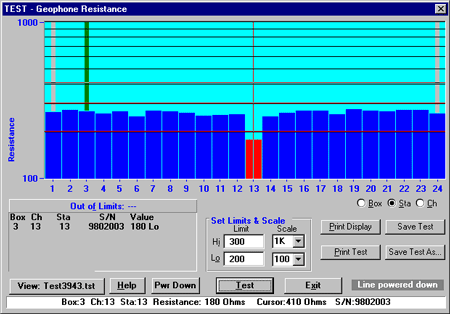
Geophone Resistance Test
|
 EX-12 ACQUISITION UNIT
EX-12 ACQUISITION UNIT
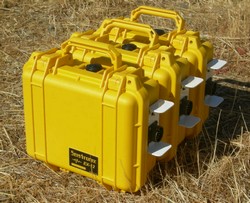
The EX-12 Acquisition Units (AU) are the backbone of the EX-12 system. They
accurately amplify and digitize the low-level seismic signals and store and
transmit the seismic data back to the laptop for display and permanent storage.
The AU electronics are shock mounted in a rugged, waterproof enclosure and
feature 24-bit A/D conversion on twelve channels, low-noise preamps with four
remotely selectable gains, sample rates of 1/8, ¼, ½, 1, 2 and 4 ms, and record
lengths up to 64 seconds per channel. Each AU has 512K of RAM for data buffering
and supports real-time operation at 2ms sample rate with 600 active channels on
a single line.
The AU has several power-saving modes that are easily controlled by the
operator. When boxes are initially connected to the spread, they are in standby
drawing a minimal amount of power waiting for commands from the operator. After
recording data, boxes can return to low-power idle mode or be kept powered up
for continuous shooting. During move-up, or other crew activity, a single click
by the operator places the spread in standby which reduces power consumption to
about 45ma per box.
Two LED status indicators on each AU provide a visual indication of the line
connection status and operation of the box. When a box is connected to the
spread, the LED status indicator flashes to verify the integrity of the cable
connection to the adjacent box, which greatly aids in the proper connection of
boxes and cables and in troubleshooting any faults without operator
intervention.
 CONTINUOUS RECORDING
CONTINUOUS RECORDING
|
The EX-12
supports continuous recording from minutes to hours. Incoming data
is continuously displayed to provide a visual indication of what is
being recorded. The screenshot below is from the EX-12 system recording seismic data continuously on 156
channels at 1ms sample rate. Data is written to disk after a
programmable interval ranging from 30 seconds to 5 minutes.
|
|
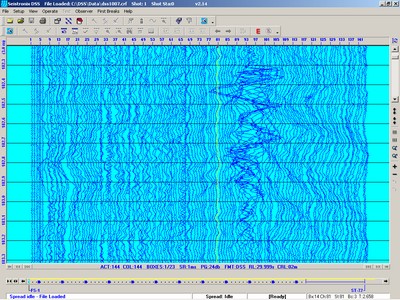
Continuous Recording
|
 LINE TAP UNIT
LINE TAP UNIT

In single line systems, the LTU allows the
recording unit to be connected anywhere in the spread. In Multiline
systems, the LTU provides line-to-line
communication. |
|
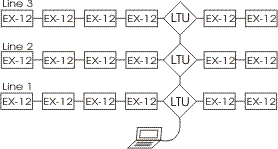 |
|
Multiline System
|
| |
 |
|
Single Line System |
 LINE INTERFACE UNIT (LIU)
LINE INTERFACE UNIT (LIU)


The LIU provides system-wide triggering and
increased distance between the recording vehicle and the spread. The LIU is
usually permanently mounted inside the recording vehicle and interfaces to the
radio shooting equipment.
Alternatively, an AUX unit (EX-12 AU programmed as an AUX)
may be used in place of the LIU to supply triggering and analog auxiliary channels to
the system. The auxiliary channels can be used to record signals from the
shooting equipment such as the pilot sweep in Vibroseis surveys.
 BP-2 BATTERY PACK
BP-2 BATTERY PACK

The BP-2 battery pack has a capacity of 10AH and can run the EX-12 for up to
two days of recording.
 BC-10 BATTERY CHARGER
BC-10 BATTERY CHARGER

The BC-10 is a three-stage smart charger with ten independent
charging stations for charging the BP-2 battery packs or other 12v Gel-Cel
batteries. It is housed in a waterproof case and runs from 110/220 volts
50/60Hz. There are two LEDs for each battery station that indicate the state of
charge.
 EXAMPLE FIELD ARRANGEMENTS
EXAMPLE FIELD ARRANGEMENTS
The
pictures below illustrate five different ways to configure the EX-12 in order of
increasing complexity. The simplest is a single EX-12 Acquisition unit connected
directly to a laptop with the most complicated system comprised of multiple lines with
the recording unit controlling the spread through a Line Bridge Unit (LBU).

Single EX-12

Single
Line 48 Channel Spread
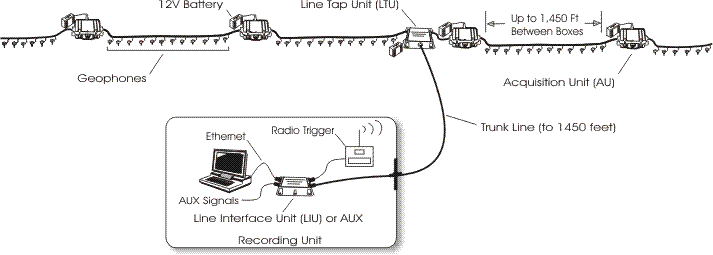
Single
Line 48 Channel Spread with Line Tap Unit (LTU)
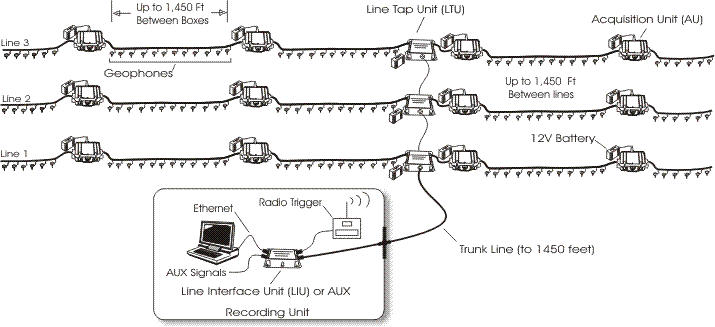
Three
Line, 144 Channel Multiline Spread
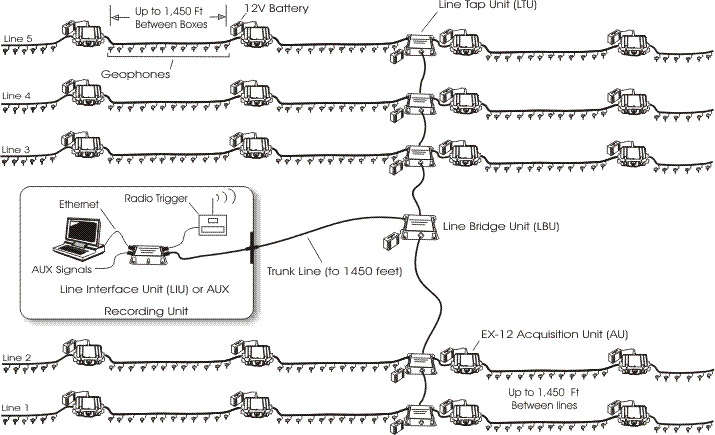
Five
Line, 240 Channel Multiline Spread with a Line Bridge Unit (LBU)

|
 |


Continuous Recording
The EX-6 now supports continuous real-time recording
for applications such as tomography and seismic interferometry. Read
more here. Mesa Scrip Support
The EX-6 now supports the use of Mesa script files for controlling the
operation of the EX-6 in 3D surveys. Read more
here.
|
